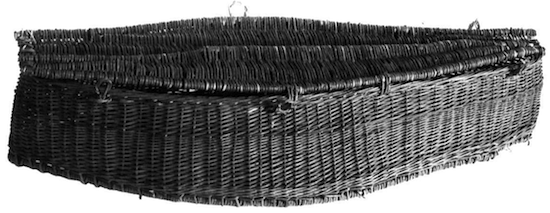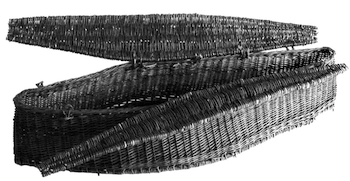
My mother planned to die at home. But she died in the hospital, near her home in Maine, because m that moment, when her growing shortness of breath so frightened and unnerved her, the hospital was where she chose to be. It was the right decision for her, and she was glad to have made it.
As she died on a Friday afternoon, there was very little time—before the appropriate offices closed for the weekend—to arrange for the physical and legal details that would free her body from regulatory limbo and allow us to bring her home. Tasks were divided among those of us gathered at her bedside and we were able by the end of the afternoon to obtain all of the necessary signatures and papers as well as a cardboard “buffalo casket” for transporting her. Hospital security cleared us to take her, then guided us down the service elevator and out the doors of the loading dock, where they watched us as we transferred my mother from gurney to casket and into my brother’s waiting van.
With candles and flowers, family members and friends had transformed my mother’s bedroom into a shrine. And my mother, lying in her own bed, in her own house, looked so at ease and so peaceful that it calmed us all, from the youngest grandchild to the most fearful adult. The softness and sense of well-being that radiated from her was not the death that we had anticipated. This was the stillness of a beloved woman at rest in her sanctuary surrounded by family and friends, children, grandchildren, dogs. The expression on her face at death, the simple beauty and dignity and authenticity of her presence, confirmed that it was right for her to be there, and right for us as well-to watch her grandchildren sit beside her on the bed and speak lovingly to her and touch her hands and smooth her gray hair, unafraid of this death, supporting her in this great unknown venture, conversant with spirit, healing their grandmother, healing themselves and their world through such simple acts of love.
For the next three days we sat with my mother, talked to her, read to her, sang to her, cried, laughed, told stories, meditated with her, prayed with her, chanted, watched birds visit her bedroom window feeders (as she loved to do). As a family, we ate our meals together at her house. As a community, we gathered at her house—that most welcoming of homes—to support her and one another. On Saturday evening, about thirty-five of us sang to her for several hours.

We gathered again Sunday morning, this time to build a raft for her, so that she could float, like Avalokiteshvara, high on the waves of birth and death, and thus journey safely to the far shore. We hand-selected wood from the lumberyard and a crew of family and friends constructed the raft in my mother’s driveway. We decorated the raft with favorite and familiar things: photographs, drawings, poems, messages, the names of all her loved ones; and we added treats and treasures for her journey.
On the third night we kept a vigil in her room. The following day, Monday, we gathered in the early afternoon to witness the boarding of the raft and to bid her farewell. And then we drove the raft to the crematorium.
In the slanted light of that late autumn afternoon we stood and watched the fire of my mother’s life rise high above the chimney of the crematorium, dissolving into blue sky, watched her raft float higher and higher, growing lighter and lighter and lighter, until no trace remained. A flock of blackbirds heading south to their wintering grounds passed through this empty sky; a herring gull soared into this western light, dipped, then turned, gliding toward the Fore River marshes. This body, her body, our body, moving everywhere now, touching everything, becoming everything.
Thank you for subscribing to Tricycle! As a nonprofit, we depend on readers like you to keep Buddhist teachings and practices widely available.